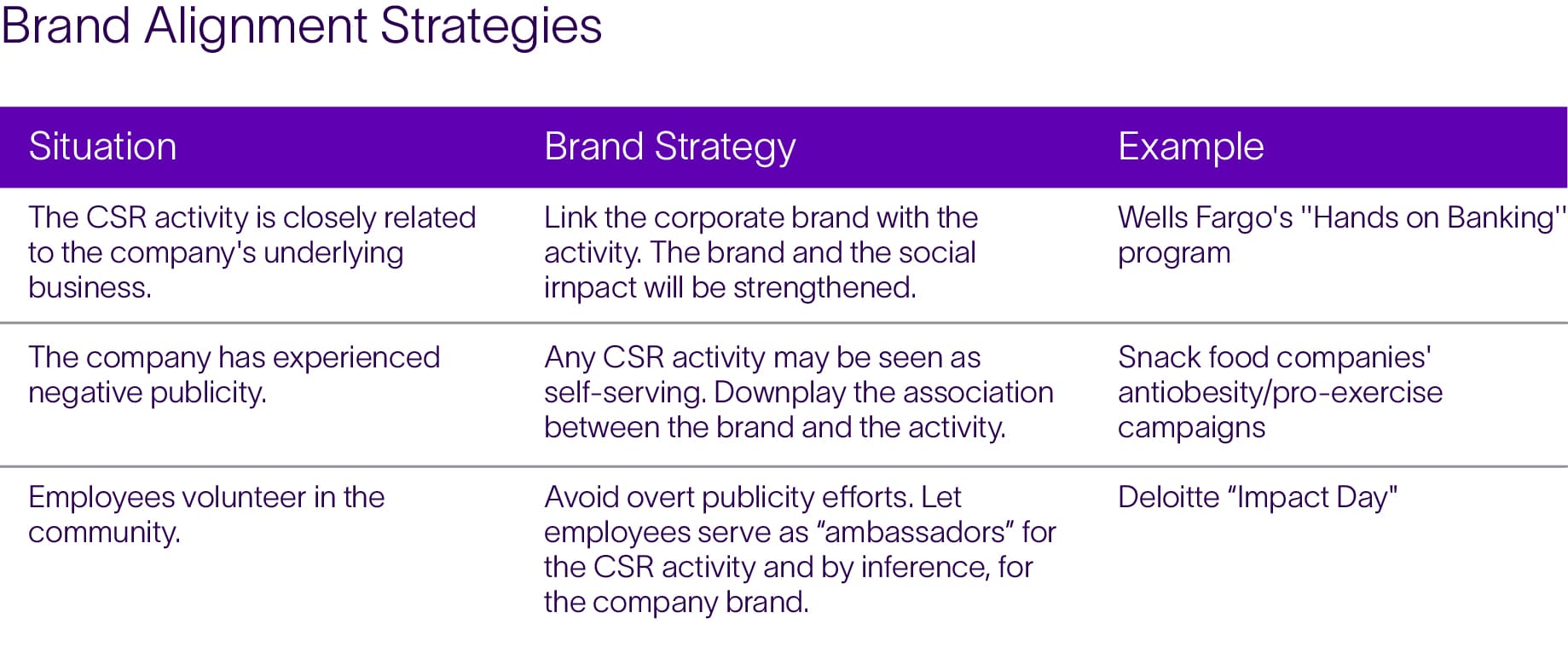When it comes to corporate social responsibility (CSR), including corporate philanthropy, is virtue always its own reward? Should companies erect firewalls between their good works and the work that makes them money? What is the appropriate balance between altruism for its own sake and using altruism to build a company’s brand and drive value creation?
There are no easy answers to these questions. But striking the right balance is vital, as opportunities to create a “halo” that casts a favorable light on the corporate brand—as CSR can powerfully do—are precious.
Point of Internal Pride or Marketplace Perception-shifter?
For good reason, leaders weigh how to position CSR in relation to the corporate brand seriously and deeply.
One high-profile financial services company retained our firm to create a branding campaign focused on its signature employee volunteerism program. Our partner knew what they wanted this campaign to do: increase participation among all employees, at all levels, across global offices. They were equally clear about what they didn’t want it to do: draw attention to the program from external audiences.
Why this reticence from one of the world’s leading financial brands? According to the firm’s director of communications, the success of the volunteer program, which had grown steadily in participation over 15 years, lay in its “purity.” Employees appreciated the fact that the firm wasn’t trying to leverage its volunteer efforts to burnish its corporate brand with favorable publicity. Even after the 2008 housing crisis, when our partner endured a slew of negative publicity, leadership resisted the temptation to use their impressive employee volunteer program to offset the reputational hit.
Navigating this kind of tension is common, and there’s no one-size-fits-all solution. However, there are principles that can guide leaders. Here are four considerations that can help align corporate social responsibility activities with the corporate brand for authenticity and impact.
The Four Principles of Authentic CSR
PRINCIPLE 1: The closer the connection between a company’s CSR activities and its underlying business, the more appropriate it is to link the two
First and most importantly, companies should evaluate the relationship between their CSR activities and their fundamental business. When the connection between a CSR activity and the company’s core business is a close one, it can be entirely appropriate to connect the two in brand marketing activities.
For example, Wells Fargo offers free educational tools and programs to build financial management skills among all age groups and economic segments, including ethnically diverse communities. Its “Hands on Banking” program, offered in English and Spanish, mobilizes the bank’s employees to teach financial management in schools and to community groups.
The Wells Fargo Foundation has also made catalytic contributions to financial literacy programs in primary and secondary educational settings. For example, it awarded a North Carolina community college a large grant to provide financial coaching that helps prevent students from being derailed by unexpected expenses.
Another client of ours, one of the nation’s top developers of shopping centers, has been a pioneer in creating “green” buildings that vastly reduce their carbon footprint. Promoting this initiative at the company’s locations helps raise awareness of environmental issues and improves its brand reputation. It’s a win-win for the environment and for the developer.
In contrast, over the last decade, a number of soft drink and snack food companies have launched philanthropic efforts aimed at encouraging physical activity among young people. While these efforts are commendable and should in no way be discouraged, they are clearly intended to counter criticism of products that are widely blamed for the epidemic of childhood obesity. These companies would be well advised to downplay the connection between these health-focused efforts and their corporate brands—neither will be helped by association with the other.
Could it still be worthwhile to make the investment in such initiatives? Certainly, for a number of reasons: bolstering employee pride, improving the companies’ stance with regulators and communities, gaining the satisfaction in “doing the right thing.” But strengthening the soft drink and snack food brands should not be the justification for the effort, and the connection to the brands should be subtle. Otherwise, it will inevitably backfire, which will hurt both their CSR efforts and their brands.
PRINCIPLE 2: When a company’s CSR activities are not closely connected with its business, create a separate brand for charitable initiatives and treat it as an extension of the corporate brand
If a company’s charitable work doesn’t directly tie to its underlying business, must the company always keep an arm’s length between the two? Absolutely not. But extra care is needed to avoid the sense that the company is exploiting its charitable work to build its business.
One successful strategy is creating a separate brand for the philanthropy and then tying that brand to the corporation. This approach creates a linkage between two brands—one charitable, the other corporate—rather than between the end beneficiaries and the corporation itself, which can be viewed as opportunistic and self-serving.
Here’s an example. Financial services company Citi wanted to support smart urban planning and governance. Beyond an affinity for “citi”-es, the initiative’s connection to financial services wasn’t a straight line. Thus, rather than funneling its contributions through its own foundation, Citi partnered with Living Cities to launch C, a program that convenes and supports local leaders as they search for out-of-the-box ways to overcome community challenges.
Citi doesn’t hide its connection to the initiative—its logo often appears as an endorser of the project. But by establishing a new entity endorsed by the company, Citi positions itself as an endorser of good governance, rather than a meddler in local politics.
PRINCIPLE 3: Employees represent the most powerful brand communications channel, so keep them informed and engaged in CSR activities
Perhaps the most fruitful way to link philanthropic or employee volunteerism programs and the corporate brand is through a company’s employee base. For most companies, and particularly those in the B2B space, employees represent the most powerful brand communications channel available. What they express about their company and its offerings—whether in a sales call, on a blog, or in a casual conversation with a reporter—can often have more impact on a company’s brand equity than an advertising campaign.
The same applies to how employees communicate with others about their company’s CSR activities. If they understand them, endorse them and—most critically—feel a part of them, they will communicate this understanding with accuracy and passion. The company won’t need to call attention to its good works. Its employees will do it for them, and in a manner that will not seem self-serving.
Keeping employees informed is thus key to successfully integrating philanthropic efforts with corporate brand building. Too often, companies fail to fully integrate their community work with their employee communications; supporting the arts, for example, is seen as a pet project of senior management rather than an endeavor in which all employees have a stake.
Making employees feel connected is about more than offering them discounted tickets to company sponsored events and matching their personal contributions. It’s about drawing a connection between the work of the company and the company’s positive impacts on the world. When they understand this connection, customers, the media and other external constituents will understand it, too.
A long-term partner of ours gets this right. They include a “community engagement” section in each employee’s human resources profile. This section, which can be continually updated by the employees to reflect hours volunteered in company-sponsored events, is used as part of employees’ annual evaluation. For this company, tracking time spent on community engagement is more than a tactic for encouraging more employee involvement; it’s a strategy that lets employees know that the company is committed to social responsibility.
When employees are directly involved in community efforts—through a company-sponsored volunteer program, for example—the opportunities for creating a corporate halo are magnified.
Deloitte, the global accounting and consulting firm, sponsors a once-a-year “Impact Day” on which tens of thousands of employees volunteer in more than 1,000 projects. Deloitte, like the financial services company noted above, doesn’t pursue publicity for its signature volunteer program. However, the firm does provide specially designed t-shirts for employees to wear when they are volunteering. It’s the best kind of brand-linkage because it’s subtle, inexpensive and does not come across as self-serving,

Subscribe to Our Newsletter
PRINCIPLE 4: Research is critical to determine the ideal relationship between a company’s brand and its CSR efforts
As with any aspect of building a brand, the key to determining the most authentically beneficial relationship between a company’s CSR activity and corporate brand is research.
We were asked by a national life and health insurance company to recommend a strategy for communicating the goals and achievements of its community activities to customers and prospects. So, we conducted focus groups in five cities with the company’s customers.
The results were eye-opening for the company’s executive team. Most of their community efforts were largely unknown, despite years of activity and community-focused advertising. And those that were known were viewed with suspicion by prospects—a none-too-transparent attempt to buy their business.
The research also uncovered a silver lining, however: customers were impressed by the insurance company’s education programs in the areas of community health and wellness, areas related to the underlying business relationship they had with the company. This information provided a blueprint for future charitable efforts and a roadmap for communicating about these efforts to customers, prospects and other external constituents.
Achieving the right relationship between your corporate brand and your community engagement is a delicate balancing act, with much at stake: the integrity of the corporate brand as well as the important work being done in the community. But it’s well worth the effort. When a company is associated with social responsibility—and its initiatives don’t come across as self-serving—it can truly be said to do well by doing good.
Want to find the most authentically beneficial relationship between CSR activity and your corporate brand? Let’s talk.
Originally published January 3, 2020.



